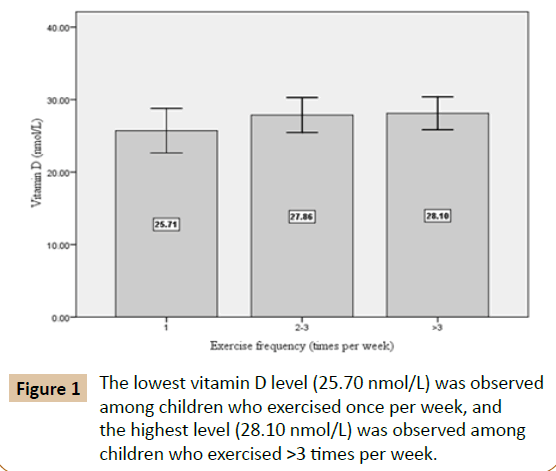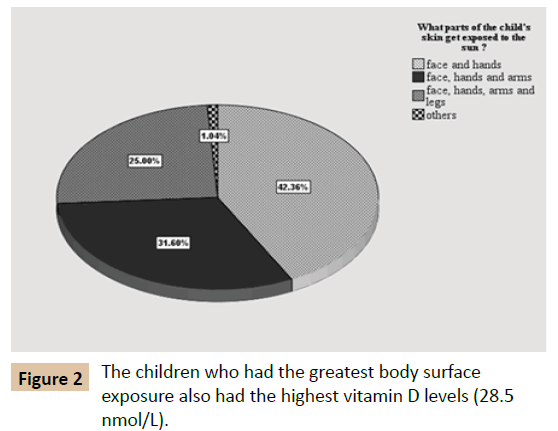The Effects of Physical Activity and Sun Exposure on Vitamin D Status among Children from Jeddah, Saudi Arabia
Almehmadi BM, Fallata EM, Alqahtani SZ and Al-Agha AE
DOI10.21767/2471-805X.100009
Almehmadi BM, Fallata EM, Alqahtani SZ and Al-Agha AE*
Pediatric Department, Ibn Sina National College, Saudi Arabia
- *Corresponding Author:
- Abdulmoein Eid Al-Agha
Abdulmoein Eid Al-Agha, Associate Professor of Pediatric Endocrinology, King Abdulaziz University Hospital, Pediatric Department, P.O. Box 80215, Jeddah 21589, Saudi Arabia.
Tel: +966505590459
Fax: +966 2 640 3841
E-mail: aagha@kau.edu.sa
Received date: January 03, 2016; Accepted date: February 23 2016; Published date: February 29, 2016
Citation: Almehmadi BM, Fallata EM, Alqahtani SZ, et al. The Effects of Physical Activity and Sun Exposure on Vitamin D Status among Children from Jeddah, Saudi Arabia. J Pediatr Care. 2016, 2:1. doi:10.21767/2471-805X.100009
Abstract
Background: The prevalence of vitamin D deficiency has increased among children and adults during the past decade. This study aimed to determine whether physical activity and sun exposure affected vitamin D status among healthy Saudi children.
Methods: This cross-sectional study included 378 Saudi children (187 girls and 191 boys) who were 4-18 years old. Their levels of physical activity and sun exposure were estimated using a questionnaire, and blood samples were obtained to analyze their vitamin D levels.
Results: We found that 371 children (98.1%) had low vitamin D levels and 7 children (1.9%) had normal levels. Children who exercised >3 times/week had higher levels of vitamin D, compared to less active children. Children who exposed the greatest number of body parts had higher vitamin D levels, compared to children who only exposed their face, hand and arms, or face. There was no correlation between low vitamin D levels and sex (deficiency: 185 girls [48.9%] and 186 boys [49.2%]).
Conclusion: Otherwise healthy children exhibited a high prevalence of vitamin D deficiency, which may be related to reduced sun exposure and physical activity. Therefore, vitamin D supplementation may be appropriate for children who have a high risk of deficiency.
Keywords
Vitamin D; Saudi Arabia; Children
Introduction
Vitamin D deficiency is a global concern, and its prevalence has increased rapidly among both children and adults during the past decade [1,2]. The high prevalence of vitamin D deficiency may be due to low skin exposure to ultraviolet radiation [3]. Unfortunately, vitamin D deficiency is a common health concern among Saudi children [4], as Saudi Arabia has unique conditions (e.g., high temperatures during the summer season) that influence vitamin D status, despite year-round sunny conditions [5]. Thus, the Saudi lifestyle typically involves large amounts of time spent in front of a computer or television, which can reduce the frequency of outdoor activities and result in limited sun exposure [6]. Furthermore, other major factors that drive vitamin D deficiency are low levels of sun exposure (i.e., insufficient outdoor activity), low levels of physical activity, and low dietary vitamin D intake [7]. Moreover, as vitamin D can be derived from sunlight (90%) and dietary intake (10%), vitamin D is recognized as the “sunshine vitamin”. Therefore, both individual and environmental factors can affect individuals’ exposure to sunlight, and limit their ability to endogenously produce vitamin D [8]. The present study aimed to examine the effects of physical activity, hot weather, and sun exposure on vitamin D status among children from Jeddah, Saudi Arabia.
Methods
This cross-sectional study evaluated vitamin D levels among healthy children between March and August 2015. The participants were 378 randomly selected boys and girls (187 girls, 191 boys) who were 4-18 years old. All data were obtained via a self-administered questionnaire that evaluated direct and indirect measures of health and wellness, and was administered during an interview with the child and their family at an ambulatory pediatric clinic. Serum levels of 25-hydroxyvitamin D [25(OH)D] were measured at the same ambulatory clinic. The child’s parents or guardians answered all applicable questions for participants who were 4-10 years old, and assisted with asking the children about their physical activity during school hours. Participants who were 11-18 years old answered all questions on their own.
The exclusion criteria were dietary or medical interventions; chronic illness; a history of cardiac, kidney, or liver diseases; a psychiatric condition; using vitamin D or calcium supplements; and insufficient data. Written and verbal consents were obtained from the parents before they completed the questionnaire. Ethical approval for this study was obtained from the Research Ethics Committee at King Abdul-Aziz University Hospital.
The questionnaire
The questionnaire included two parts that evaluated physical activity and sun exposure. Physical activity was evaluated using questions and self-evaluation regarding the type, frequency (daily, weekly, monthly, or rarely), and duration (30 min, 1 h, and >1 h) of each exercise. Sun exposure was evaluated using questions regarding the duration of daily sun exposure (min per day) and the percentage of the body surface that was exposed (based on the child’s daily clothing habits). For body surface exposure, we estimated 5% for face and hands; 10% for hands, arms, and face; and 20% for hands, arms, face, and feet.
Vitamin D status
Blood samples were collected by laboratory technicians, and serum levels of 25(OH)D were measured at the King Abdul-Aziz University Hospital laboratory (Jeddah, Saudi Arabia). The normal range for vitamin D was defined as 50-75 nmol/L, deficiency was defined as <25 nmol/L, insufficiency was defined as 25-50 nmol/L, and elevated levels were defined as >75 nmol/L.
Statistical analysis
Data were entered, coded, and analyzed using SPSS software (version 16; SPSS Inc., Chicago, IL). The frequencies and percentages of physical activity and sun exposure were reported using descriptive statistics. We analyzed the differences in vitamin D levels using one-way analysis of variance for the categories of physician activity, sun exposure, and body surface exposure, based on the assumption of normal distribution. Differences were considered statistically significant at a p-value of < 0.05.
Results
This study included 378 children (183 girls, 191 boys), with a mean age of 9.4 years (95% confidence interval: 9.3-9.5 years). Among all the children who were screened, 51.4% exercised regularly and 48.6% did not. Therefore, we divided the children who exercised regularly into three groups according to exercise frequency: once per week (22.7%), 2-3 times per week (38.7%), and >3 times per week (38.7%). The lowest vitamin D level (25.70 nmol/L) was observed among children who exercised once per week, and the highest level (28.10 nmol/L) was observed among children who exercised >3 times per week (Figure 1).
Among a subgroup of 306 children with complete sun exposure data, 222 children (72.5%) reported being exposed to the sun and 84 children (27.5%) reported no exposure. Most of the children who were exposed to the sun reported that they only exposed their face and hands (42.4%); 31.6% of the children exposed their face, hands, and arms; and 25.0% of the children exposed their face, hands, arms, and legs (Figure 2). The children who had the greatest body surface exposure also had the highest vitamin D levels (28.5 nmol/L) (Table 1).
| Variables | N | Percentage | Mean Vitamin D level (nmol\L) | P-value | ||
|---|---|---|---|---|---|---|
| Body surface exposure | ||||||
| Face and hands | 122 | 42.4% | 26.4 | 0.238 | ||
| Face, hands, and arms | 91 | 31.6% | 26.7 | |||
| Face, hands, arms, and legs | 72 | 25.0% | 28.4 | |||
| Other | 3 | 1.0% | 18.1 | |||
| Period of sun exposure | ||||||
| 7 AM–9 AM | 127 | 49.2% | 27.8 | 0.398 | ||
| 10 AM–3 PM | 63 | 24.4% | 25.5 | |||
| 3 PM–5 PM | 34 | 13.2% | 25.5 | |||
| 5 PM–7 PM | 34 | 13.2% | 26.2 | |||
| Duration of sun exposure | ||||||
| <1 h | 148 | 52.5% | 27.6 | 0.483 | ||
| 1–2 h | 81 | 28.7% | 26.1 | |||
| 2–4 h | 33 | 11.7% | 27.6 | |||
| >4 h | 20 | 7.1% | 24.6 | |||
Table 1 Vitamin D levels and the study variables.
The mean vitamin D levels were highest among children who were exposed to the sun during 7 AM-9 AM (27.84 nmol/L). However, the recommended time for sun exposure (10 AM-3 PM) had the lowest vitamin D levels (25.5 nmol/L), which may explain the relatively low vitamin D levels in most of the participants. There was no evidence to suggest a significant relationship between vitamin D level and the duration of sun exposure during the day, as all samples for the various periods had relatively low vitamin D levels. Furthermore, there was no correlation between low vitamin D levels and sex (185 girls [48.9%] and 186 boys [49.2%]).
Discussion
Vitamin D deficiency is common among Saudi children and adults. Therefore, the present study aimed to investigate the vitamin D status among children from Jeddah, and to examine the effects of physical activity and sun exposure on vitamin D status. The main source of vitamin D is via skin synthesis in response to sun exposure. However, there are large numbers of children with vitamin D deficiency, even in countries with no seasonal differences in sunlight [9]. Interestingly, most vitamin D-deficient children do not perform physical activity (60.6%) and have no exposure to sunlight (57.5%) [7]. Furthermore, a study of 427 healthy Italian adolescents reported that low levels of sun exposure, performing outdoor physical exercise <3 times per week, and excess weight affected vitamin D status [8].
The weather in Jeddah is hot and humid throughout the year, and the air temperature ranges from 36°C to 46°C (average: 42°C). Thus, children remain indoors (e.g., watching TV and playing computer games) to avoid the heat and sun exposure. The avoidance of sunlight may also be related to concerns regarding skin damage and health. This may explain why the children in the present study exhibited reduced outdoor physical activity levels. Similar findings and reasons have been reported for Malaysian children (402 boys and girls, 7-12 years old), and the authors reported that the parents were concerned regarding their children’s safety and did not allow them to play outside the home [7]. Thus, decreases in sun exposure and outdoor activity are observed in the summer, with increases observed during the winter and spring [10].
A cross-sectional study evaluated 331 healthy Saudi boys and girls (6-17 years old) from the middle of Saudi Arabia, and found that physically inactive children with no sun exposure had lower vitamin D levels than physically active children with sun exposure (16 nmol/L vs. 22.4 nmol/L, respectively) [1]. Another Arabic study collected data during different seasons from 3 private schools, with 169 participants in the spring, 177 participants in the fall, and 83 individuals who participated in both seasons. The results revealed that girls had lower vitamin D levels during both seasons (vs. boys), which may be because girls covered their body more than boys (32% vs. 9% in spring and 7.5% vs. 0% in fall, respectively). Furthermore, 52% of the children had vitamin D insufficiency [9]. A cross-sectional study in Qatar (which has similar weather) evaluated a random sample of 458 children (228 boys and 230 girls; <16 years old) who visited primary healthcare centers, and found that the prevalence of vitamin D deficiency among the children was 68.8%, which was likely due to the high temperatures limiting sun exposure [11].
Overweight children also have a high risk of vitamin D deficiency, due to increased deposition of vitamin D in their fat, which decreases its bioavailability [12]. Furthermore, exercise significantly affects vitamin D status by increasing skin exposure to sun light and decreasing body fat [13]. Nevertheless, the traditional bulky Muslim garments that are worn in Saudi Arabia and other Middle Eastern countries may restrict outdoor physical activity (especially for girls), and increase the risk of vitamin D deficiency.
Conclusion
We observed a high prevalence of vitamin D deficiency among otherwise healthy children in the present study. Limited sun exposure and outdoor physical activity of <3 times per week affected vitamin D status. Therefore, measures are needed to improve the awareness of children and their parents regarding the benefits of exposure to sunlight, and particularly regarding an appropriate level of body surface exposure. Furthermore, the promotion of a healthier lifestyle that involves regular outdoor physical activity is important for maintaining vitamin D levels. Moreover, we recommend routine screening for vitamin D status, and supplementation for children who have a high risk of vitamin D deficiency.
References
- Al-Othman A, Al-Musharaf S, Al-Daghri NM, Krishnaswamy S, Yusuf DS, et al. (2012) Effect of physical activity and sun exposure on vitamin D status of Saudi children and adolescents. BMC Pediatr 12: 92.
- Mansour MM, Alhadidi KM (2012) Vitamin D deficiency in children living in Jeddah, Saudi Arabia. Indian J EndocrinolMetab 16: 263-269.
- Bener A, Al-Ali M, Hoffmann GF (2009) High prevalence of vitamin D deficiency in young children in a highly sunny humid country: a global health problem. Minerva Pediatr 61: 15-22.
- Bener A, Al-Ali M, Hoffmann GF (2009) Vitamin D deficiency in healthy children in a sunny country: associated factors. Int J Food SciNutr 60(Suppl 5): 60-70.
- Bischoff-Ferrari HA, Giovannucci E, Willett WC, Dietrich T, Dawson-Hughes B (2006) Estimation of optimal serum concentrations of 25-hydroxyvitamin D for multiple health outcomes. Am J ClinNutr 84: 18-28.
- El-Hajj Fuleihan G, Nabulsi M, Choucair M, Salamoun M, Hajj Shahine C, et al. (2001) Hypovitaminosis D in healthy schoolchildren. Pediatrics 107: E53.
- Khor GL, Chee WS, Shariff ZM, Poh BK, Arumugam M, et al. (2011) High prevalence of vitamin D insufficiency and its association with BMI-for-age among primary school children in Kuala Lumpur, Malaysia. BMC Public Health 11: 95.
- Vierucci F, Del Pistoia M, Fanos M, Erba P, Saggese G (2014) Prevalence of hypovitaminosis D and predictors of vitamin D status in Italian healthy adolescents. Ital J Pediatr 40: 54.
- Walker GE, Ricotti R, Roccio M, Moia S, Bellone S, et al. (2014) Pediatric obesity and vitamin D deficiency: a proteomic approach identifies multimericadiponectin as a key link between these conditions. PLoS One 9: e83685.
- Reesukumal K, Manonukul K, Jirapongsananuruk O, Krobtrakulchai W, Hanyongyuth S, et al. (2015) Hypovitaminosis D in healthy children in Central Thailand: prevalence and risk factors. BMC Public Health 15: 248.
- Al-Saleh Y, Al-Daghri NM, Khan N, Alfawaz H, Al-Othman AM, et al. (2015) Vitamin D status in Saudi school children based on knowledge. BMC Pediatr 15: 53.
- Dawodu A, Wagner CL (2007) Mother-child vitamin D deficiency: an international perspective. Arch Dis Child 92: 737-740.
- Rajpathak SN, Rimm EB, Rosner B, Willett WC, Hu FB (2006) Calcium and dairy intakes in relation to long-term weight gain in US men. Am J ClinNutr 83: 559-566.
Open Access Journals
- Aquaculture & Veterinary Science
- Chemistry & Chemical Sciences
- Clinical Sciences
- Engineering
- General Science
- Genetics & Molecular Biology
- Health Care & Nursing
- Immunology & Microbiology
- Materials Science
- Mathematics & Physics
- Medical Sciences
- Neurology & Psychiatry
- Oncology & Cancer Science
- Pharmaceutical Sciences


